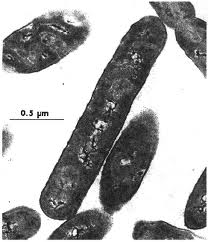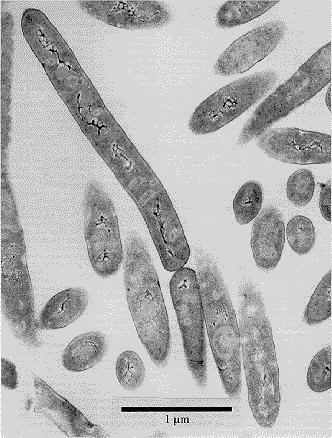Bacillus infernus
Thin-section electron micrograph of Bacillus infernus, sp. nov., isolated from ca. 2.7 km below land surface in the Taylorsville Basin. These new species proposed by D. R. Boone et al. (1995) are thermophilic, halotolerant, and Fe(III)- and Mn(IV)-reducing anaerobes. Photo from http://geoweb.princeton.edu/research/geomicrobio/bacteria.html
A Microbial Biorealm page on the genus Bacillus infernus
Higher order taxa
Bacteria; Firmicutes; Bacilli; Bacillales; Bacillaceae; Bacillus
Species
Bacillus infernus
Nonmotile rods (including possible yet unconfirmed endospores) inhabiting the deep terrestrial subsurface of the Taylorsville, Virginia Triassic Basin. The organism is thermophilic, halotolerant, and slightly alkaliphilic. B. infernus is important because it can affect geochemical processes including transport of toxic chemicals similar to other subsurface microorganisms. B. infernus also possesses a “novel” metabolism perhaps useful in future bioremediation of the environment, biotechnology, and industry[1].
Genomic information
Entire genome not sequenced yet. 16S rDNA partial sequencing of two anaerobic strains (Th-22 and TH-23) have been studied via PCR amplification. The isolated portion contains nearly the entire gene; approximately 1500 base segments[1][2]. The study concluded B.infernus should be classified as a new Bacillus species based on RDP database information[1][2][3][4].
Cell and colony structure
Cells are Rod shaped. Dimensions are 0.7μm X 0.8μm in width by 4.0μm X 8.0μm in length. Endospores seem possible but as yet undetermined. Colony growth is pinpoint[1].
Metabolism
Ecology
Deep terrestrial subsurface; Known samples obtained from depths of 2.65 to 2.77 km in the Taylorsville Triassic basin, Virginia. Bacillus infernus is thermophilic (61ºC), halotolerant (0.6 M Na+), and very slightly alkaliphilic (pH 7.3 to 7.8) [1].
References
[1]Boone, D. R., Liu, Y., Zhao, Z., Balkwill, D. L., Drake, G. R., Stevens, T. O., & Aldrich, H. C. (1995). Bacillus infernus sp. nov., an fe(iii)- and mn(iv)-reducing anaerobe from the deep terrestrial subsurface. International journal of systematic bacteriology, 441-448. doi: 10.1099/00207713-45-3-441. http://www.ncbi.nlm.nih.gov/pubmed/8590670
[2]Boone, D. R., Liu, Y., Zhao, Z. J., Balkwill, D. L., Drake, D. R., Stevens, T. O., & Aldrich, H. C. (2009, March 05). Bacillus infernus strain TH-23 16s ribosomal rna, partial sequence. Retrieved from http://www.ncbi.nlm.nih.gov/nuccore/NR_027227.
[3]Balkwill D.L.,Bacillus infernus TH-22 16s small subunit rRNA gene, partial sequence. (1995, May 18). Retrieved from http://www.ebi.ac.uk/ena/data/view/U20384
[4]Balwill, D. L. (1195, July 9). Bacillus infernus sp. nov., an Fe(III)- and Mn(IV)-reducing anaerobe from the deep terrestrial subsurface. Retrieved from http://rdp.cme.msu.edu/hierarchy/hierarchy_browser.jsp?qvector=65535&depth=0&openNode=0&seqid=¤tRoot=2268&searchStr=bacillus%20infernus&endDataValue=&showOpt=
Edited by Matt Flynn, a student of Dr. Lisa R. Moore, University of Southern Maine, Department of Biological Sciences, http://www.usm.maine.edu/bio




